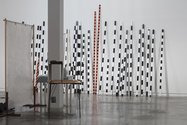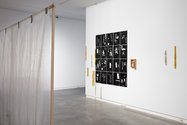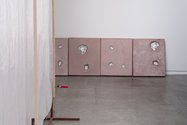John Hurrell – 27 February, 2017
The show is driven by two artists who have a real ambivalence about the dominant methodologies and ideologies of the scientific research they are nevertheless fixated on. Cullen in particular is fascinated by various patterns of investigative procedure, showing a lot of affection - he loves what he also undermines - whilst also visually (diagrammatically in drawings, and physically in vulnerably rickety freestanding sculptures) dismantling their underpinning stabilising assumptions. This is a wavering oscillation, not an all-out assault.
Last June a version of this exhibition was presented in the Ilam Campus Gallery in Christchurch, and now it has surfaced in Arch Hill as a new iteration to be seen by Paul Cullen‘s local home community. In both exhibitions, his sculpture was assisted by the published words and key curatorial decisions of fellow university lecturer, Allan Smith - who in both cases was co-exhibitor - but this installation is quite different from its predecessor. Some components have changed: it is less icy and has a wider sweep of referents - and the space is less institutional.
The show is driven by two artists who have a real ambivalence about the dominant methodologies and ideologies of the scientific research they are nevertheless fixated on. Cullen in particular is fascinated by various patterns of investigative procedure, showing a lot of affection - he loves what he also undermines (1) - whilst also visually (diagrammatically in drawings, and physically in vulnerably rickety freestanding sculptures) dismantling their underpinning stabilising assumptions. This is a wavering oscillation, not an all-out assault.
The title of the exhibition, Provisional Arrangements, firstly refers to the standard view of science as a discipline where any dominant model of ‘reality’ is only valuable until a more convincing hypothesis replaces it, and secondly, much of the show is made of portable constructions assembled on the site, using clamps, knots, props, balancing weights etc. for temporary stability when joined up. Thirdly, it also suggests epistemological instability, a restless, constantly sliding foundation that is always futile, and can never have certain or permanent relevance. Existentially the research project is permanently doomed. You want meaning in life; a higher truth embedded in the world? Hey Buddy, best forget it.
The organisational structure of the show has some similarities to the structures of Smith’s published, deftly organised, essay. Cullen‘s use of assembled (collected) elements like say painted rocks placed in groups on the floor, or different shaped cement weights stored on shelves, have affinities with Smith’s characteristic infatuation with lists, where certain paragraphs are collections of sentences or clauses starting with ‘or’ or ‘to’. Sometimes Smith is riffing on words like ‘apparatus’, chewing at them like a dog on a bone, just as Cullen in a wall of drawings riffs on scientific investigations that are doomed to fail if he obliterates certain crucial nexus, which he does mentally with obscuring black circles.
Obscuring is often the name of the game. Matte black paint hides the mineral substance that provides the core of the ‘rocks’, so we can’t guess at their weight unless we pick them up. Provisional clamped screens of translucent plastic partially obscure images on the wall of other experiments (the spatial positioning of furniture), so that even when examining them directly close up, it takes a while to see that each photocopied print is inverted.
What is used to cover over and hide can also be made to protect. Tin foil is used to cover parts of scorialike gritty rocks (red and blue types) that seem to reference meteorites that have left craters in a shower - ostensibly numbered and documented in stacked pink plaster trays and a three-quarter view gridded photograph. Reflective foil (as a radiation blocking material) is also used to cover two domes, one small smooth earthlike hemisphere that is in close proximity to a rotating plastic bean that constantly clambers in circumnavigation over its open carrying case, and a much larger planar geodesic type (with earth maps inserted inside its observation slots) that would normally be a satellite tracking station and which now looks downward and in instead of up and out.
With a stack of research books on plant propagation, skewered by a wonky ‘stake’ of joined up red pencils, or a music stand converted to a vertical height measurer (with a extended horizontal rule and pointless yellow pencil), we see Cullen‘s strong sense of carefully controlled, restrained dada, an ambivalent ambient mental cloud of futility that oppressively hovers over visual observation and methodical record keeping. Pencilled notations can be easily erased, smeared or tampered with, and even pencils themselves can attack the devised purposes of their own design.
Leaning against the far innermost end of the gallery are 40 black/white stakes and 5 red/black ones, all with different sets of unnumbered - tonally alternating - measuring calibrations. The confusing jumble is there to remind us of the multiplicity of available options, with any one allegedly ‘correct’ system repudiated. Against another wall, metal shelves hold 35 cement weights with cords, differently shaped methods of ensuring the stability of three-legged tables via strategically positioned holes from which to suspend them, and even stacking one table upon the other.
Height, gravity and precarious unstable masses are favourite Cullen thinking points. Condensed loci around which to construct wonderfully absorbing exhibitions. Assorted strategies that tease you into reassessing basic foundations. You might not dismiss them, but you may not reflexly embrace them either.
John Hurrell
(1) A good example is demonstrated by his recent work in the Waiheke Headlands: Sculpture On The Gulf exhibition where viewers were able to take away a beautiful coloured map of the island’s geological structure, as well as admire the sculpture of a bucketed platformed garden (provisionally) resting on humps. It had the opposite ethos from the more overtly ‘deconstructive’ 2011 black ink drawings in the Two Rooms exhibition. The map embraced a faith in the validity of science.





















 Two Rooms presents a program of residencies and projects
Two Rooms presents a program of residencies and projects Advertising in this column
Advertising in this column



This Discussion has 0 comments.
Comment
Participate
Register to Participate.
Sign in
Sign in to an existing account.